
Citing the harsh impacts of climate change, the governor introduced an $8 billion plan to preserve the state’s diminishing water supply

The West’s water system is reaching a “tipping point,” Bureau of Reclamation head says
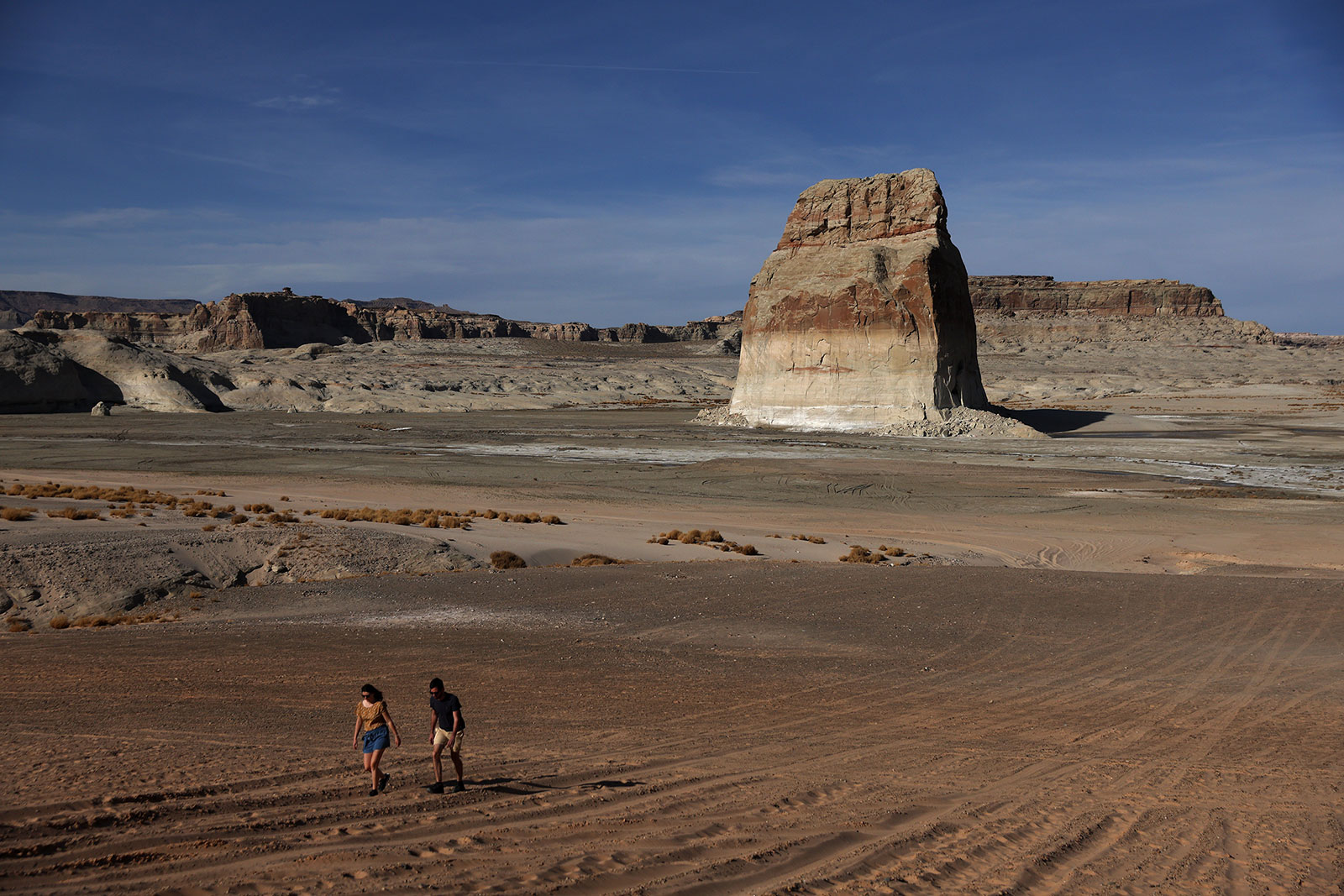
The drought in the Colorado River basin is reaching “a tipping point,” Camille Calimlim Touton, the Bureau of Reclamation Commissioner, said. Her remarks come as the bureau announced its forecast for the water system in the West at a time when the region is experiencing a multi-year megadrought made worse by the climate crisis.
Touton said the Colorado River basin is in its 23rd year of a “historic drought.” This year’s forecast prompted the bureau to declare a Tier 2 water shortage on the Colorado River — forcing several Southwest states to make mandatory water cuts for the second year in a row.
The commissioner said Lake Powell and Lake Mead — the country’s two largest reservoirs — are also at “historically low levels.”
“The system is approaching a tipping point and without action we cannot protect the system and the millions of Americans who rely on this resource,” Touton said.
By taking conservation actions, like water cuts, she said the bureau needs to ensure communities, tribal nations and the environment are sustained, not just next year but for the future
“Protecting the system means protecting the people of the American West,” she said.
New water cuts coming for Southwest as Colorado River falls into Tier 2 shortage
From CNN’s Ella Nilsen

The federal government announced Tuesday the Colorado River will operate in a Tier 2 shortage condition for the first time starting in January as the West’s historic drought has taken a severe toll on Lake Mead.
According to a new projection from the Department of the Interior, Lake Mead’s water level will be below 1,050 feet above sea level come January — the threshold required to declare a Tier 2 shortage starting in 2023.
Lake Mead’s level has been around 1,040 feet this summer, just 27% of its full capacity.
The Tier 2 shortage means Arizona, Nevada and Mexico will have to further reduce their Colorado River use beginning in January. California will not have cuts made to to their Colorado River yet. (The threshold for California’s first cut is 1,045 feet in January.)
Of the impacted states, Arizona will face the largest cuts — 592,000 acre-feet — or about 21% of the state’s yearly allotment of river water.
“Every sector in every state has a responsibility to ensure that water is used with maximum efficiency. In order to avoid a catastrophic collapse of the Colorado River System and a future of uncertainty and conflict, water use in the Basin must be reduced,” Interior’s assistant secretary for water and science Tanya Trujillo said in a statement.
Interior’s projections show that by January of next year, Lake Mead’s water surface elevations will be at 1,047.61 feet. Meanwhile, Lake Powell’s water surface elevation will be at 3,521.84 feet – 32 feet above minimum power pool, or the amount needed to generate electricity from hydroelectric operations.
Separately, US Bureau of Reclamation Commissioner Camille Touton and other federal water officials said they are prepared to take additional administrative actions needed to protect the Colorado River, Lake Powell and Lake Mead from falling to “critically low levels.”
Earlier this summer, Touton set a deadline of mid-August for the seven Colorado River states to come up with a plan to cut as much as 25% of their river water usage. It became apparent early this week that those negotiations have stalled, which led some lawmakers and state water officials to call on the federal government to take aggressive action on their own.
Interior has not yet outlined next steps in Touton’s demand for the states’ plan.
The federal government is asking states for massive water cuts
From CNN’s Ella Nilsen
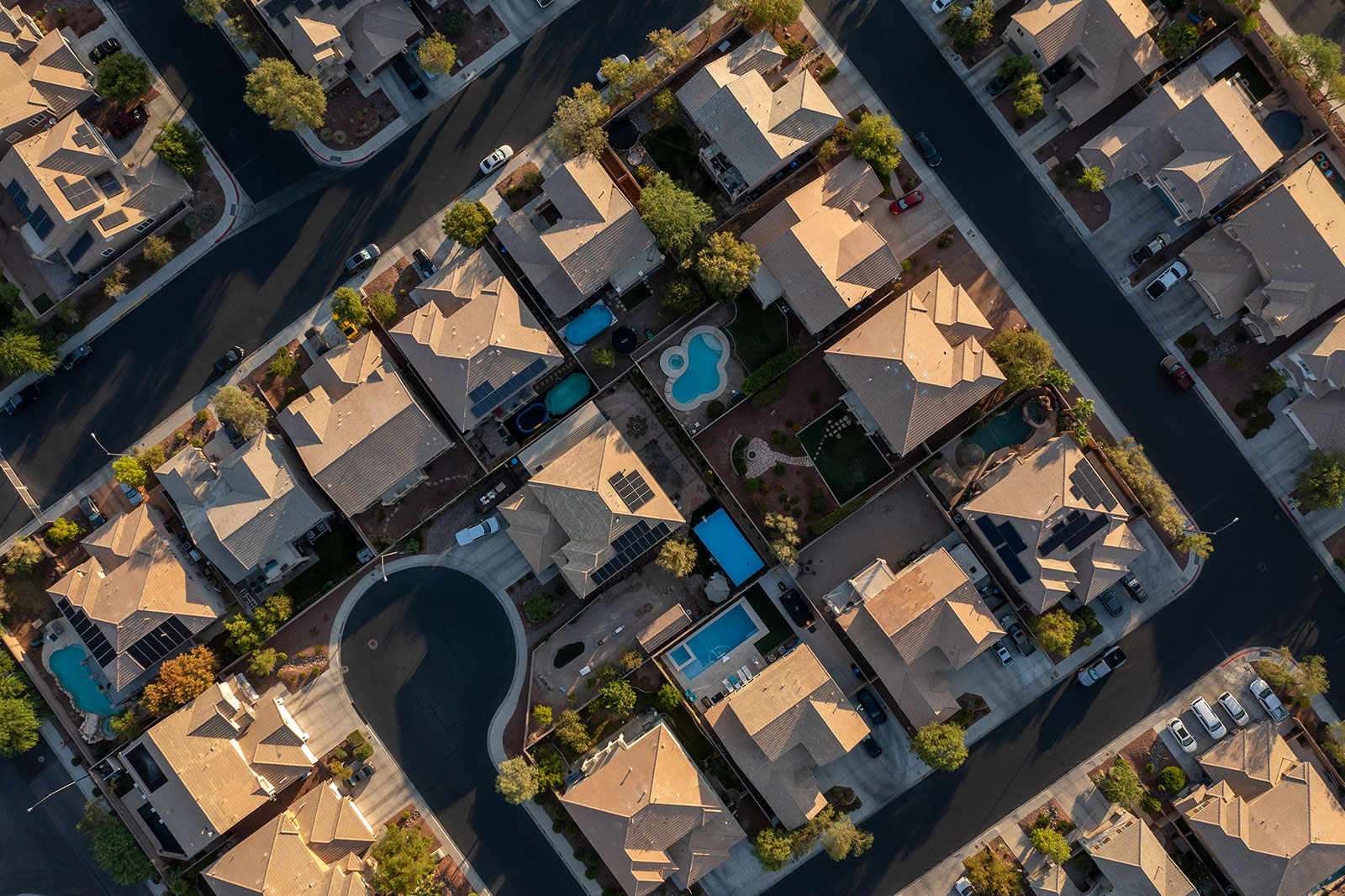
At a June Senate hearing, Reclamation Commissioner Camille Touton laid out a stark warning. In order to stabilize the Colorado River basin, states and water districts would have to come up with a plan to cut 2 to 4 million acre-feet of water usage per year by mid-August, or the federal government would step in and devise a plan for them.
It’s a massive amount — the high end of the target is about 25% less water than states currently receive. And the low end of the target represents the vast majority of Arizona’s yearly allotment of Colorado River water.
Touton made clear in June the federal government would act if the states didn’t.
“It is in our authorities to act unilaterally to protect the system, and we will protect the system,” Touton said at the time. “We need to see the work. We need to see the action. Let’s get to the table and let’s figure this out by August.”
Reclamation has not often stepped in and taken control of water management plans from the states, but it has the authority to do so in the lower Colorado River basin — which includes Arizona, southern Nevada and southern California. Experts told CNN the threat of federal action is something states will respond to.
“We kind of need the federal government to make some threats to spur action,” John Fleck, a West water expert and professor at University of New Mexico, told CNN earlier this year. “Progress seems to happen when the federal government comes in and says to states, you need to do this or we’re going to do something you don’t like.”
Steep water cuts on tap for the Southwest as Colorado River dries up amid drought
From CNN’s Ella Nilsen and Rachel Ramirez

An extraordinary drought in the West is drying up the Colorado River and draining the nation’s largest reservoirs – Lake Mead and Lake Powell. And amid the overuse of the river and the aridification of the region, the federal government is preparing to make mandatory water cuts and asking states to devise a plan to save the river basin.
Two major announcements could come Tuesday:
- A forecast from the US Bureau of Reclamation that could trigger the first-ever Tier 2 water shortage for the Lower Colorado River Basin
- The bureau’s next step in its demand that the seven states in the river basin come up with a way to voluntarily cut up to 25% of their water usage — or the federal government will do it for them.
The growing concern is that the mandatory cuts aren’t enough to save the river in the face of a historic, climate change-driven drought.
“We thought we were good, but the last few years have been so dry that we realized those tier reductions weren’t enough and aren’t enough,” Bill Hasencamp, the Colorado River resources manager with the Metropolitan Water District of Southern California, told CNN. “So the two things we’re focused on is how do we get through the next three years without the system crashing, and then how do we develop a long term plan to sustain the Colorado River.”
At a June Senate hearing, Bureau of Reclamation chief Camille Touton laid out a stark warning: In order to stabilize the Colorado River Basin, states and water districts must come up with a plan to cut 2 to 4 million acre-feet of water usage by next year. (An acre-foot is the amount of water that would fill one acre a foot deep — roughly 326,000 gallons.)
She also made clear that if the states cannot come up with a plan, the federal government will act.
“It is in our authorities to act unilaterally to protect the system, and we will protect the system,” Touton said at the time. “We need to see the work. We need to see the action. Let’s get to the table and let’s figure this out by August.”
Keep reading here.
What is a “dead pool,” and why does it matter for Lake Mead?
From CNN’s Payton Major and Brandon Miller
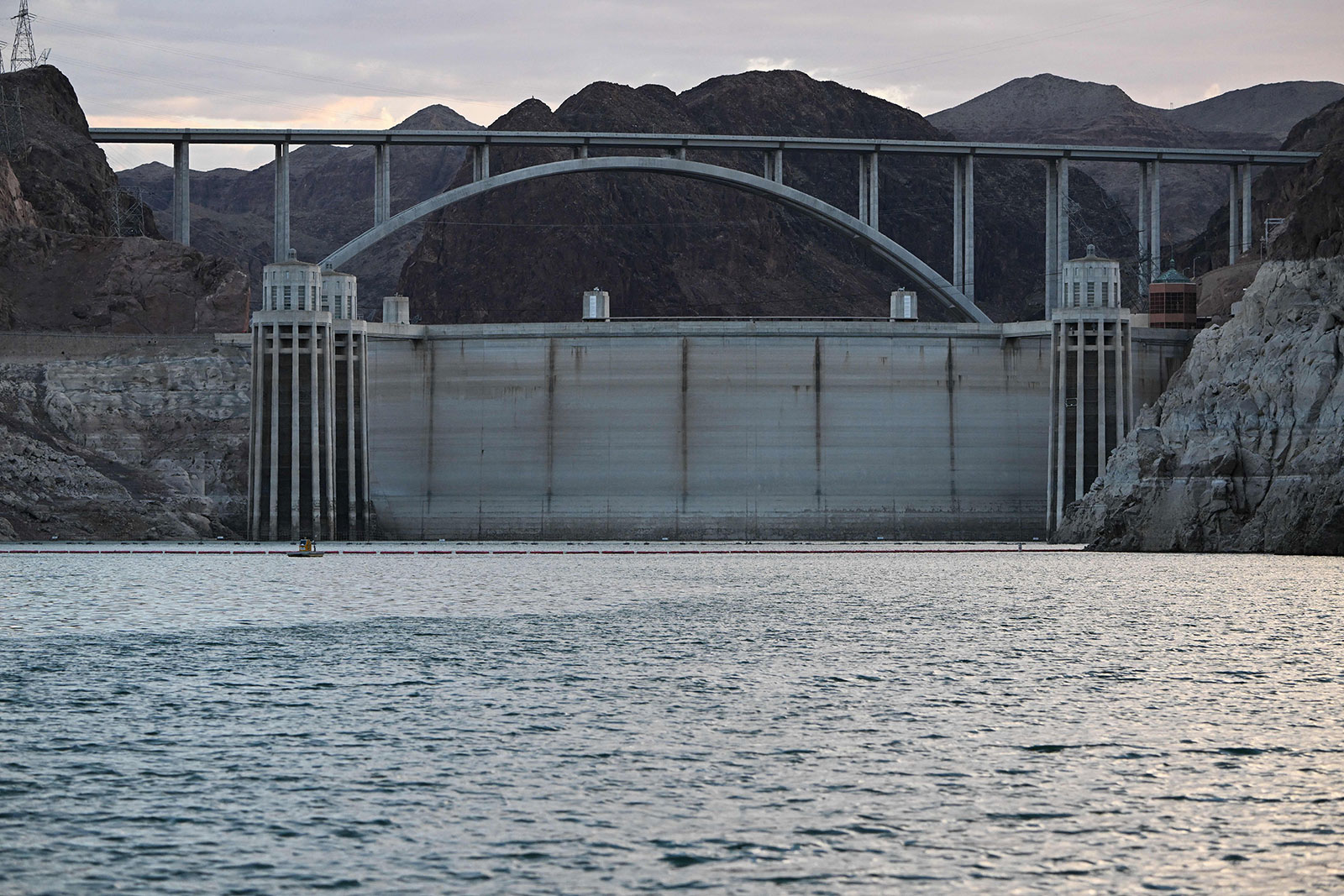
Amid an intense drought stretching for more than two decades, the Colorado River basin’s water supply is rapidly declining, and worrisome projections continue to show Lake Mead plummeting toward “dead pool” status — when a reservoir isn’t high enough to release water downstream through a dam.
Before reaching dead pool levels however, a lake would first reach “minimum pool status,” which is the point when a dam can no longer produce hydroelectricity due to a lack of water in the reservoir.
Lake Mead’s water level is currently around 1,040 feet above sea level — around 145 feet away from reaching dead pool status, which is at 895 feet of elevation. Remember, water levels are measured by elevation relative to sea level, not by actual water depth in the lake.
The Hoover Dam houses turbines that are powered by the force of water to generate electricity. But they will struggle to generate hydropower as the water level falls toward dead pool level. Halting hydroelectricity production at the Hoover Dam would impact 1.3 million people across Arizona, Nevada and California.
Neighboring Lake Powell is also dangerously close to minimum pool levels. As of Aug. 9, the lake was at 3,534 feet of elevation, just 44 feet away from ceasing electricity production at the Glen Canyon Dam. Dead pool at Lake Powell comes in at 120 feet lower, when the elevation falls to 3,370 ft.
This is the current status of the West’s drought
From CNN’s Brandon Miller
Around 70% of the West is in drought conditions as of last Thursday, according to the US Drought Monitor. Nearly 300,000 square miles of that — an area larger than any single state in the continental US — is considered in “extreme” or “exceptional” drought, the most intense categories.
These designations indicate areas of major crop loss, shortage of water in reservoirs, streams and wells requiring restrictions and eventually creating water emergencies, per the Drought Monitor’s website.
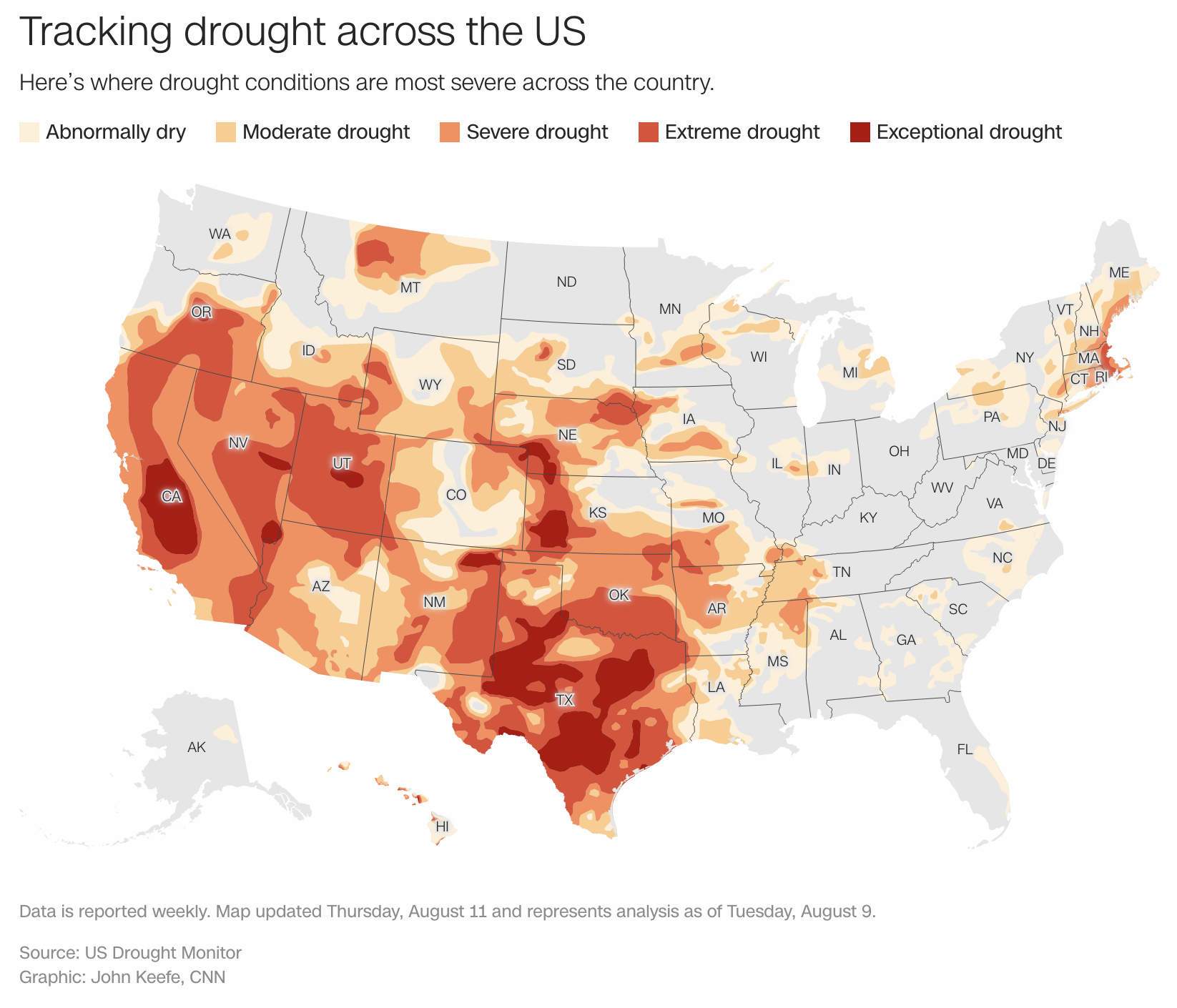
Yet as dire as the situation is, last week’s report was an improvement. A year ago at this time, 90% of the West was in drought and twice as much of the area was mired in the worst two categories, compared to now.
Back-to-back active Southwest monsoon seasons — which run from June 15 through September — have eased drought conditions over much of the desert Southwest including New Mexico, Arizona and Colorado.
But it will take a lot more than that to erase the West’s historic drought, which has been entrenched for more than 20 years. Not every year since 2000 was drier-than-average, but the water debt in the soil and reservoirs has been accumulating and there has been at least some portion of the West with drought present in every weekly Drought Monitor update since early 2000.
Scientists have noted that the current megadrought is the worst that Western North America has seen in 1,200 years. The West is no stranger to significant dry spells and droughts, but the human-caused climate crisis has supercharged the current one, making it 72% worse than it would have been without global warming.
UN: As Lake Mead and Lake Powell dry up, water regulation may not be enough to maintain hydropower
From CNN’s Payton Major and Brandon Miller
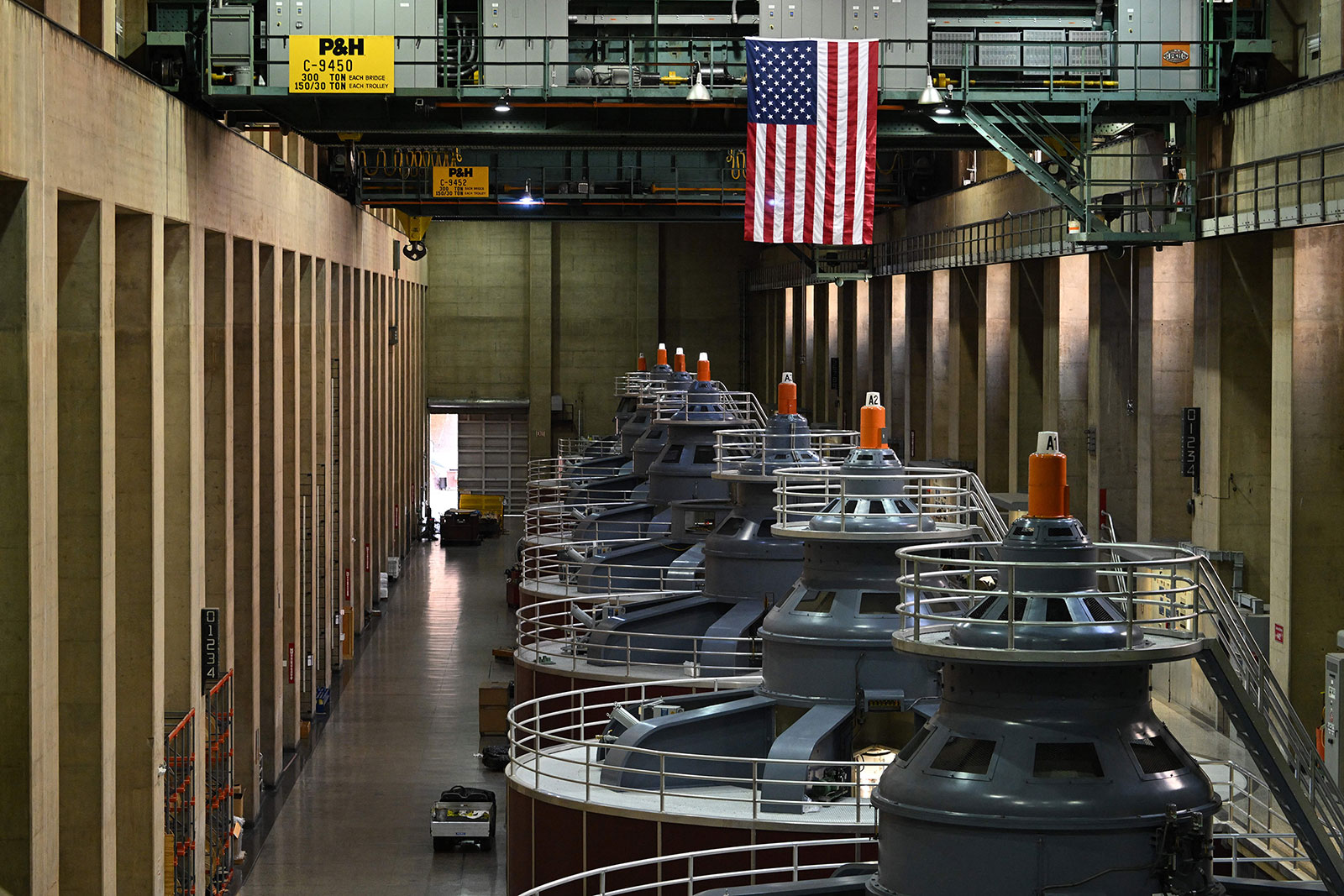
Lake Powell and Lake Mead are at historically low levels and risk falling to “dead pool” status, which would mean there isn’t enough water to generate hydroelectricity for the tens of millions of people that rely on it, according to United Nations Environment Programme.
Water cuts are necessary, the UN reports, to maintain adequate supply in reservoirs and continue hydroelectric production.
But that still may not be enough, according to experts, who say climate change is the heart of the issue.
Lis Mullin Bernhardt, an ecosystems expert at UNEP, says “we’re no longer speaking of a drought,” as the Colorado River basin is experiencing a “new very dry normal.”
The West’s booming population has led to a spike in water demand and enhanced the impact of the climate crisis. Areas with more frequent drought will have to rely on groundwater — water that pools below ground and can only be reached by digging wells — which will continue to deplete with a lack of rainfall.
“We are talking about a 20-year period of drought-like conditions with an ever-increasing demand on water,” Bernhardt said. “These conditions are alarming, and particularly in the Lake Powell and Lake Mead region, it is the perfect storm.”
The reservoirs provide hydroelectric power and water for Nevada, New Mexico, Arizona, California, Wyoming, and Colorado, as well as part of Mexico.
Why the Colorado River is so important
From CNN’s Rachel Ramirez
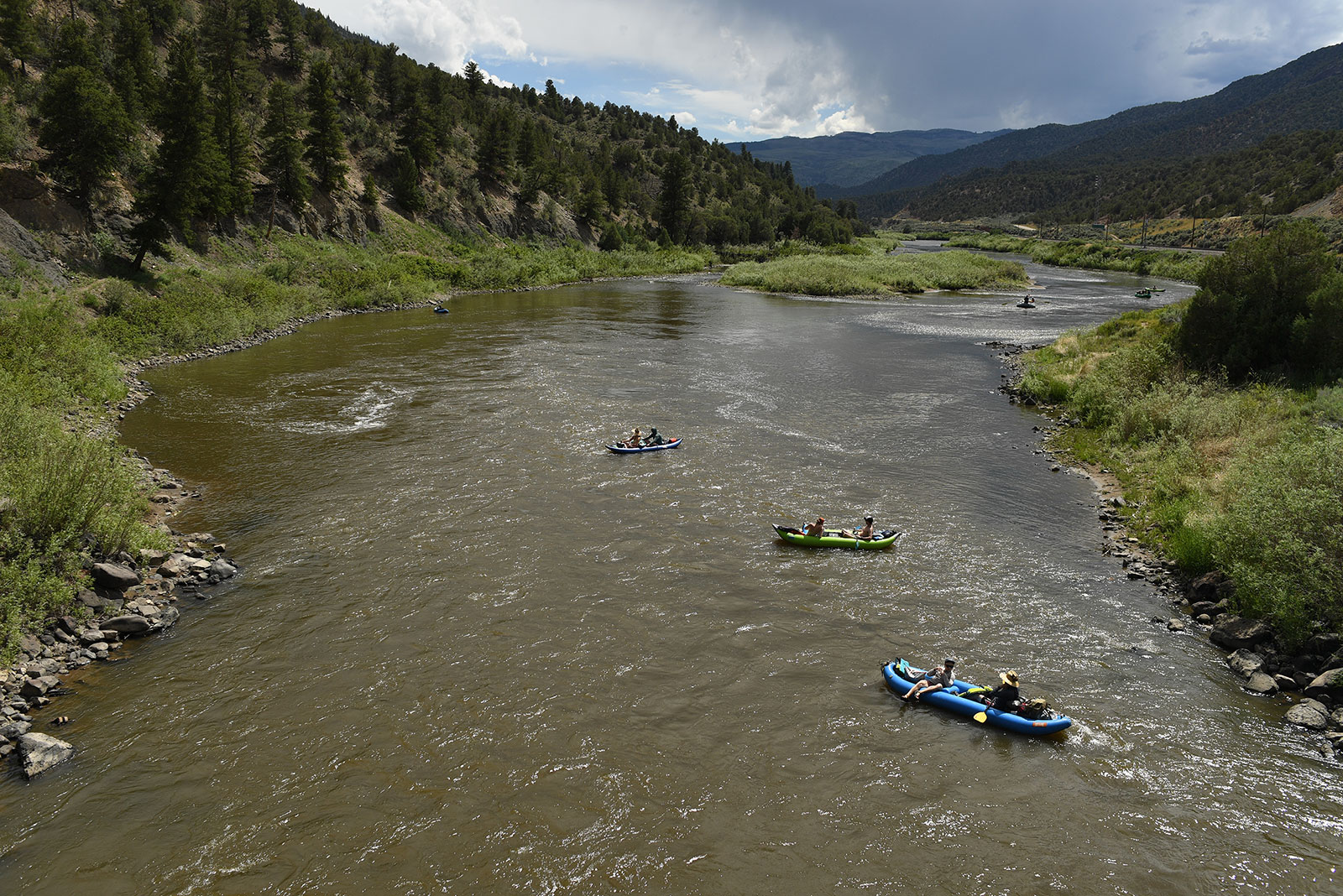
The Colorado River and its tributaries flow through seven states – Wyoming, Utah, Colorado, New Mexico, Nevada, California and Arizona – and Mexico. And that system supplies water and hydropower to 40 million people and irrigates more than 5 million acres of farmland.
Las Vegas relies on the Colorado River for 90% of its water supply, Tucson for 82% and San Diego for around 66%. Large portions of the water consumed in Los Angeles, Phoenix and Denver also come from the river, and water experts say these thriving metropolises would not have been possible without its critical supply.
But the system is now under threat. Plagued with overuse and a changing climate, the Colorado River’s two main reservoirs — Lake Mead, the largest in the country, and Lake Powell — have drained at an alarming rate.
The underlying issue goes back nearly 100 years ago to the signing of the Colorado River Compact, a water-sharing agreement that determines how the river’s supply is divvied up and allocated across the basin states. States allocated the river’s water during a time of abnormally high precipitation — making it seem like the water would always be plentiful.
US Bureau of Reclamation data shows that over the last two decades, the river’s flow has been 25% less than what states originally assumed in their pact. And studies show it could drop another 35-50% by 2200.
“They thought there was a lot more water in the river than there actually was, so the river has actually always been overallocated,” Kristen Averyst, senior climate advisor for Nevada Gov. Steve Sisolak, told CNN. “Now we’re in a situation where climate change is really loading the dice.”
The Colorado River compact was “historic.” But it overestimated how much water there is
From CNN’s Rachel Ramirez
The Colorado River’s water was divvied up a century ago. The seven states it flows through – Wyoming, Utah, Colorado, Nevada, California, Arizona and New Mexico – agreed to a pact that gave half of the river’s water to the Upper Basin states and half to the Lower Basin.
“The states did something historic: they took destiny into their own hands and made a plan on how they’re going to share the river,” Bill Hasencamp, the Colorado River resources manager with the Metropolitan Water District of Southern California, told CNN. “Not the federal government and not local entities, but as seven states coming together to chart the future of the West, which turned the West into an agricultural and economic powerhouse on the Colorado River.”

There was one major problem: Having been written at a time when precipitation was higher than normal, that agreement overestimated how much water flows through the Colorado River. It also did not account for the West’s hotter and drier future in the face of the climate crisis.
“We went [almost] 100 years without water shortages. It very well may be that we’ll never have a full allocation again,” Hasencamp added. “This is permanent shortages and so the way we look at water in the West has got to change. Water will never be the same in the West.”
As the West faced more intense droughts, states agreed in 2007 to a shortage system that would lead to mandatory water cuts. Those cuts are tied to the water level in Lake Mead – a reservoir on the Lower Colorado River, and the country’s largest.
The federal government announced the first of those unprecedented cuts in August 2021 when a Tier 1 shortage was declared. A Tier 2 shortage – and a fresh round of cuts – could be announced Tuesday.
Source: https://www.cnn.com/us/live-news/lake-mead-colorado-river-report#h_8b9a61776c746ca11392b63b158381f6


















